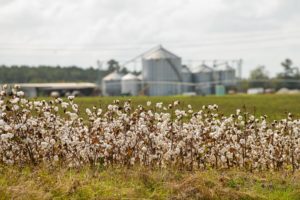FLORENCE, S.C. – New varieties, coupled with improved nematode management and fertility practices have helped increase cotton yields and Clemson University cotton specialist says if environmental conditions cooperate, South Carolina cotton farmers could see an increase in yields this year.
During the 2021 Cotton Growers Meeting, held online, Clemson Cooperative Extension Service cotton specialist Mike Jones said variety and environment are key to growing a successful cotton crop.

“Fiber quality – especially strength and length – are primarily controlled by the variety of the plant, or the plant’s genetics,” Jones said. “But, what the environment does throughout the growing season is key to the type of crop farmers will have at the end of the season.”
According to Jones, if farmers plant cotton varieties with average or below average fiber quality and the growing season results in drought or high heat, fiber lengths can take a hit and quality could decrease. But, if farmers plant varieties that have above average fiber length there’s a chance they won’t have any problems.
“When it comes to variety selection, you have to do your homework,” Jones said. “You have to study the available data and temper it with your experiences to find varieties that will work best for you.”
Jones said it also is important to spread risks over planting and maturity dates.
Referencing the 2020 season, Jones said 2.3 million acres of cotton were harvested in the Southeast. In South Carolina, farmers harvested 185,000 acres of cotton with an average of 778 pounds of lint per acre.
Controlling leafroll dwarf virus and bacterial blight
John Mueller, Clemson cotton pathologist, talked about diseases and pests, including the cotton leafroll dwarf virus. This disease is transmitted by aphids and overwinters in weeds located around field edges. It was first reported in Alabama in 2017 and found in South Carolina in 2019. It also has been detected in Florida, Georgia, Mississippi and Texas.
“We’ve had a pretty extensive project in South Carolina looking for this disease,” Mueller said. “We can find quite a bit of this virus, but it has been at very low incidences in individual fields. The bottom line for us is we’re having a very hard time showing any yield loss due to this virus.”
Virus symptoms vary and include shortened internodes and stunted plants, but the most common symptoms are yellowing and crinkling of the leaves.
“I think when most people see this, the first thing they think of is herbicide damage similar to that seen with 2, 4-D,” Mueller said. “So, farmers probably are going to have a hard time determining what’s herbicide damage and what’s actually from the virus. Anyone who has any concerns about this can contact their local county agent who can collect and submit samples to test for the virus.”
Bacterial blight is another disease to watch. Information from Cotton Incorporated shows symptoms include small, water-soaked lesions, or spots, on seedling leaves, as well as leaves of mature plants. Unlike many other lesions on cotton leaves that are more-or-less circular, those associated with bacterial blight are more triangular or rectangular. Bacterial blight lesions may appear on the upper leaf surface however, the water-soaked or “greasy” appearance of the lesions is often most clearly detected on the underside of the leaf. Lesions on tops of leaves are sometimes encircled by a yellow ring or so-called “halo.”
Information from the South Carolina Pest Management Handbook for Field Crops shows fungicides are ineffective against this bacterial disease. Farmers concerned about bacterial blight should plant resistant varieties.
Dealing with Target spot and Areolate mildew
Mueller also talked about Target spot and Areolate mildew. Information from the South Carolina Pest Management Handbook shows Target spot is caused by Corynespora cassiicola and has become common in some areas of the southeastern United States. It often is linked to areas with excessive rainfall in midseason, especially if rank growth is present. There are fungicides are labeled for Target spot control. However, because this disease is not common, reliable application timings and rates have not been established.
Areolate (false) mildew, caused by Ramularia areola, is a relatively new fungal leaf disease of cotton in South Carolina. The first significant reports of this disease in the state came in 2018. Last year, Mueller said he had reports of the disease showing up in 10 or 12 fields with minimal yield loss reported.
Similar to Target spot, Areolate mildew is not common. It is favored by excessive rainfall in midseason and rank plant growth. The disease appears to be more easily controlled by fungicides than Target spot. For both Target spot and Areolate mildew, fungicides must be sprayed at the first sign of the disease to achieve significant control.
Mueller said farmers should keep a watch on irrigated fields for all of these diseases.
Noting nematodes
Southern root-knot nematode is a pest that has been plaguing cotton in South Carolina and other southeastern states for the past two decades. Mueller said “we’ve come a long way in those 20 years” with several resistant varieties currently being released for commercial sales.
“In the past, companies would release a root-knot resistant variety but it never sold well because yield drags were very real,” he said. “We’ve got some varieties now that look like they’re going to work.”
Mueller said two varieties have shown resistance to root-knot and reniform nematodes. Researchers believe this will allow farmers to plant root-knot nematode-resistant cotton varieties as rotation crops with susceptible soybeans. The jury is still out on using this practice in fields plagued with reniform nematodes. In fields with Columbia lance nematodes, peanut is the only crop that when rotated with cotton will reduce Columbia lance nematode populations. Peanut rotations also can help with southern root-knot and reniform nematode infestations.
Nematicides can also be used effectively to control nematodes in row crops. This pesticide is broken out into two major groups based on the level of nematode pressure needed to control this pest. The first group is for fields with high nematode populations. Telone II is the only “stand alone” nematicide for fields with heavy nematode pressure. It is applied as a pre-plant fumigant. Other treatment regimens for fields with heavy nematode pressure include AgLogic 15G or Velum Total in-furrow, at-planting plus post-emergence applications of AgLogic 15GG side-dressed or Return XL or Vydate C-LV sprayed over the top.
The second group of nematicides can be used in fields with low-to-moderate nematode pressure and includes AgLogic 15GG in-furrow at-planting and commercial seed treatments including AVICTA Complete Pak, AERIS Seed Treatment System, or COPeO Prime. COPeO Prime contains fluopyram, the active ingredient in Velum. AVICTA Complete Pak contains a nematicide (Abamectin), an insecticide (Cruiser) and a combination of fungicides (Dynasty CST). AERIS Seed Treatment System contains a nematicide (Larvin) and an insecticide (Gaucho Grande). The inclusion of Trilex Advanced Seed Applied System fungicides is optional. Return XL or Vydate C-LV can also be applied post-emergence in combination with at-plant treatments of AgLogic 15GG, Velum Total or seed treatments such as AVICTA Complete Pak or AERIS Seed Treatment System for additional nematode control in fields with low to moderate nematode pressure.
“We have some excellent weapons to use in our fight against nematodes,” Mueller said. “But before you decide which ones to use, you have to make sure you’re choosing the correct ones. Know what nematode or nematodes you have in your fields so that you can choose the nematode resistance with the best available agronomic benefits.”
About 80% of the South Carolina cotton crop is planted the first week in May. Cotton harvest begins in late September.
-END-
Get in touch and we will connect you with the author or another expert.
Or email us at news@clemson.edu

